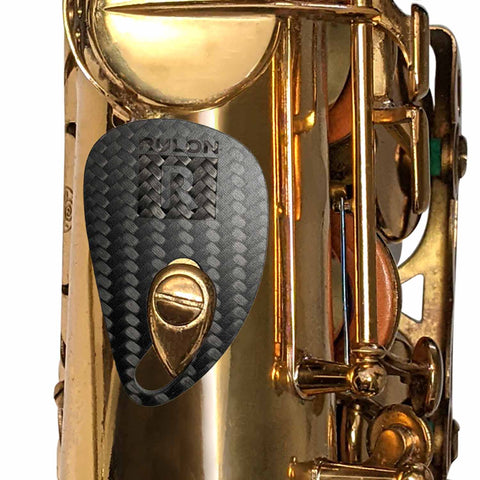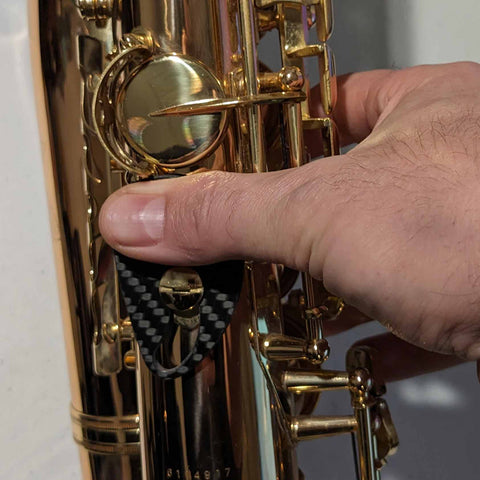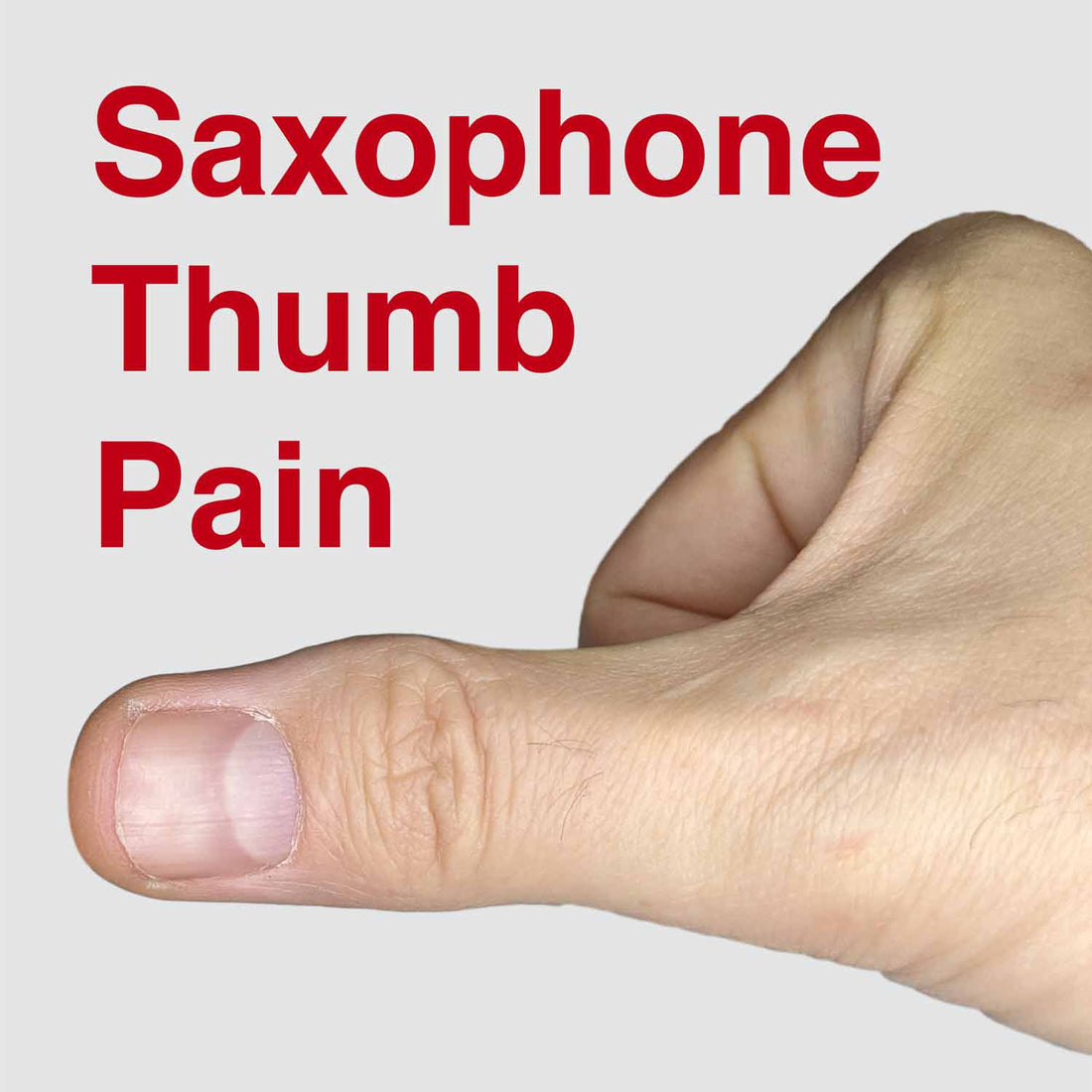by Linda R. Stine, retired occupational therapist who often worked with hand therapy patients
 I recently tried the RULON saxophone thumb rest and here are my thoughts. But first, a bit of introduction. I am certainly NOT a professional musician. Four years ago, at age 65 I suddenly decided that what I wanted to do yet in life was learn to play the saxophone. I had played the flute all through school and college, but had not been involved in music at all for more than four decades. I started with sax lessons and have been playing my alto every single day ever since for an hour or more just because the sax is so darn fun to play. I am now in a local college saxophone ensemble as well as a summer community band. So I am serious about playing every day, but will never get beyond this very amateur "just play for enjoyment" level. Also of note is my status as a retired occupational therapist who often worked with hand therapy patients.
I recently tried the RULON saxophone thumb rest and here are my thoughts. But first, a bit of introduction. I am certainly NOT a professional musician. Four years ago, at age 65 I suddenly decided that what I wanted to do yet in life was learn to play the saxophone. I had played the flute all through school and college, but had not been involved in music at all for more than four decades. I started with sax lessons and have been playing my alto every single day ever since for an hour or more just because the sax is so darn fun to play. I am now in a local college saxophone ensemble as well as a summer community band. So I am serious about playing every day, but will never get beyond this very amateur "just play for enjoyment" level. Also of note is my status as a retired occupational therapist who often worked with hand therapy patients.
First - I love this new RULON thumb rest!!! I don't know why this isn't standard design on saxophones!
 With the standard saxophone thumb hook rest, I had been developing a rather annoying callous on the medial side of my thumb joint as well as a pressure point on the side tip of my middle finger. Also I was becoming increasingly aware of tension in my right upper extremity and shoulder area. So I knew something needed to change, but the therapist in me couldn't quite identify exactly what. I thought maybe the RULON saxophone rest could solve the thumb callous problem, but I was surprised to find out that it actually addresses the entire issue of my right side.
With the standard saxophone thumb hook rest, I had been developing a rather annoying callous on the medial side of my thumb joint as well as a pressure point on the side tip of my middle finger. Also I was becoming increasingly aware of tension in my right upper extremity and shoulder area. So I knew something needed to change, but the therapist in me couldn't quite identify exactly what. I thought maybe the RULON saxophone rest could solve the thumb callous problem, but I was surprised to find out that it actually addresses the entire issue of my right side.
 With the standard saxophone thumb hook rest, I had been developing a rather annoying callous on the medial side of my thumb joint as well as a pressure point on the side tip of my middle finger. Also I was becoming increasingly aware of tension in my right upper extremity and shoulder area. So I knew something needed to change, but the therapist in me couldn't quite identify exactly what. I thought maybe the RULON saxophone rest could solve the thumb callous problem, but I was surprised to find out that it actually addresses the entire issue of my right side.
With the standard saxophone thumb hook rest, I had been developing a rather annoying callous on the medial side of my thumb joint as well as a pressure point on the side tip of my middle finger. Also I was becoming increasingly aware of tension in my right upper extremity and shoulder area. So I knew something needed to change, but the therapist in me couldn't quite identify exactly what. I thought maybe the RULON saxophone rest could solve the thumb callous problem, but I was surprised to find out that it actually addresses the entire issue of my right side.- I'm not a tinkerer, but switching out the standard rest for the Rulon sax rest was easily accomplished by using a penny to turn the screw on my Yamaha custom Z to remove the old rest and insert and adjust the new one.

- The Rulon sax rest adjusted easily left or right as well as up or down so I could find the best fit for me. Now the pad of my entire thumb is in contact with the thumb rest instead of just the medial side of my thumb knuckle. Hooray!

- Right from the get go I realized that I needed to adjust my shoulder harness to raise my saxophone maybe half an inch or so. With the standard thumb rest I had apparently been using my thumb to help hold the sax, and I had never realized it. With the weight of the instrument now off of my right hand, already there was less tension throughout my right upper extremity and shoulder. Another immediate plus!! And surprise - I didn't need my thumb to hold the sax, only to push it away from my body!
- I found the biggest advantage of the Rulon sax rest when I actually started to play. The new rest does not force my hand to conform to the position required to fit my thumb into the hook of the standard thumb rest. This didn't just change the position of my thumb, it also allowed me to naturally shift the position of my entire wrist! It allows my wrist to be positioned in a more neutral position that is ergonomically more advantageous to optimal functioning for fine coordination and dexterity of the fingers.

Try this experiment:
Hold your hand comfortably out in front of you palm face down with your wrist in a neutral position. Now wiggle your fingers quickly as if you are playing the piano or typing as fast as you can. Notice the ease and speed with which your fingers move while your wrist is in this neutral position.
Hold your hand comfortably out in front of you palm face down with your wrist in a neutral position. Now wiggle your fingers quickly as if you are playing the piano or typing as fast as you can. Notice the ease and speed with which your fingers move while your wrist is in this neutral position.
Now try that again, but THIS time position your hand so that your wrist is bent up AND it is also angled towards your thumb. In this rather strained wrist position, try wiggling your fingers quickly to again play an imaginary piano. Notice the difference - your fingers move with less ease and speed - less dexterity. NOW, holding your hand in that same slightly awkward position of wrist bent back and towards your thumb, bring your arm down to your side where it would probably be while playing the alto sax while seated. That awkward wrist position is where my hand needed to be in order to fit my thumb to the standard saxophone hook rest. Obviously, it's NOT the wrist position for optimal dexterity.
- The resultant improvement in wrist position promoted improvement in my finger dexterity - most notably for right middle, ring, and little fingers. Voila! A particular right hand passage that I had been struggling with for my ensemble music suddenly became easier! As a sax player, I was surprised, but as a therapist it was sort of a "Duh! Of course!" sort of moment.
- Also, the resultant improvement in wrist position helped to decrease the tension throughout my whole right side - all the way up to and including my right upper trapezius muscle in my upper back. I would never have guessed that so much of my problem was stemming from trying to conform my right hand to the demands of the old saxophone thumb rest hook!!! But that is indeed the case.
Overall, I am delighted with my experiment with the wooden Rulon trial rest (also, thank you for making it out of wood ). I will be purchasing one of the upgraded rests (either the gold one or the black braided fiber one) and using the wooden one to loan to any of my other sax playing acquaintances who are curious about giving this a try. Or, I might give it to my teacher so he can loan it to any of his students who might want to try it. There is certainly a case to be made for having this style of saxophone rest be standard equipment.

